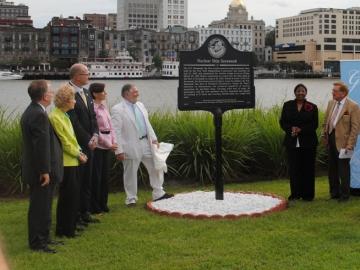
Section Branding
Header Content
NS Savannah Sails Into History
Primary Content

Georgia marked the 50th anniversary of a history-making ship. The first nuclear-powered vessel used for commercial purposes sailed into Savannah on August 22nd, 1962. Even though the NS (Nuclear Ship) Savannah only sailed for 10 years, its boosters say, it's still relevant today.
It was the height of the Cold War. The nuclear bombs dropped on Hiroshima and Nagasaki in Japan were still in living memory. And President Eisenhower wanted to show nuclear power could be used for peace. So the NS Savannah was built in New Jersey and sailed into its namesake port with much fanfare.
Joel Rice was there. The Savannah native says, tens of thousands came out to Savannah's waterfront to greet not only a new form of technology but what everyone thought would become a new age.
"They called it the Nuclear Age," Rice says. "Nuclear power was going be this thing and they said it was going to be so cheap that you wouldn't even monitor it for electricity, much less for cargo ships."
Rice was one of a few dozen people who returned to the waterfront for the unveiling of a historical marker to the ship. Jane Kahn had a folder with photos and other mementos from the occasion. One of them shows Kahn with her husband and their three young children.
"This is a picture of my family, 50 years ago, on the NS Savannah," Kahn says. It was huge. It was amazing."
The Savannah was named for the SS Savannah, the first steam ship to cross the Atlantic. The first Savannah made its historic voyage in 1819. Wendy Melton of Savannah's Ships of the Sea Museum says, like the first Savannah, the nuclear ship was ahead of its time.
"It was short of a showpiece," Melton says. "It was a demonstration piece to sort of calm the fears after World War Two of nuclear power to demonstrate that it could be used in a peaceful manner."
The NS Savannah was built to carry both cargo and passengers. And some historians say, it never could do both very successfully. It sailed around the world 21 times without ever refueling, or making a profit, before it was decommissioned in 1972. It now sits in a Baltimore shipyard, where some hope it will become a museum. Todd Groce of the Georgia Historical Society presided over the marker dedication.
Some people also would like to see that ship and museum here, an expensive proposition for sure. For now, though, Savannah has a historic marker near the convention center on Hutchinson Island.
Among those who spoke at the unveiling, Naval chaplain, Lieutenant Len Driskol noted the ship's future isn't just about location. He says, the NS Savannah is still relevant today.
"We live in a world where the energy crisis, I think, might not be as bad as it was at other times in our history, but it's certainly on people's minds when you're paying almost $4 a gallon for gas and we believe that a lot of these resources are not renewable," Driskol says.
Georgia is still home to nuclear powered submarines, at Kings Bay Naval Base. And new nuclear reactors for electric power are being built about a hundred miles upriver at Plant Vogtle.
Tags: Savannah, Plant Vogtle, GPB News, Georgia Historical Society, orlando montoya, Todd Groce, NS Savannah, Joel Rice, Wendy Melton, Savannah's Ships of the Sea Museum, Ships of the Sea Museum, Sea Museum, Len Driskol, Kings Bay Naval Base, Nuclear Ship, SS Savannah
